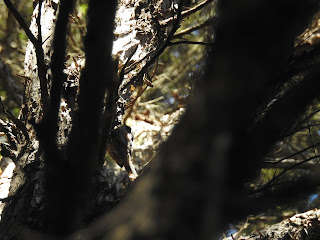The New Zealand pigeon is often seen while driving in the New Zealand countryside
New Zealand bellbirds are extremely common, we saw them often during the trip
Our first stop of the day was the Orokonui Ecosanctuary, about 30 minutes drive from the castle. We started walking along the kaka trail at about 9:30 am. The feeders were alive with bellbirds and tui. After about a minute of waiting, a feeding flock of magnificent lifer kaka swept through the area, giving us our first views of the endemic parrot. We then headed towards the Robin Valley Trail. We stood along the first third of the trail and silently waited. A flock of distant lifer brown creepers made their way through the canopy. Eventually, our target, a lifer South Island robin, flew down and briefly checked us out. On the way back, a male tomtit perched near the path and allowed close views.
The kaka on South Island are slightly more colourful than their North Island cousins
Tui gave us great views at the sanctuary's many feeders
The male tomtit has a beautiful yolk-yellow wash to his chest
A horrible shot of one of the brown creepers at Robin Valley
We got lunch in Dunedin, then drove back to the castle. After a few minutes rest, we went to Penguin Place for a 3 o'clock tour. While walking past several little penguins, we saw New Zealand fur seals hauled up on the rocks. Variable oystercatchers were common here. We walked down to an area of trenches, from which we observed a pair of yellow-eyed penguins. Just before heading back, we scanned the beach for birds and managed to see a yellow-eyed penguin rise from the water and walk across the beach.
A pair of variable oystercatchers stares down a young New Zealand fur seal
Jim and Maggie are the names of these two yellow-eyed penguins
A yellow-eyed penguin strides slowly across the beach









No comments:
Post a Comment